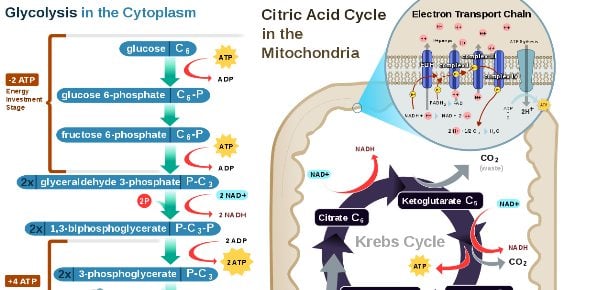Is Cellular Respiration Your Forte? Find Out With This Quiz!
-
Energy is made during respiration in the form of what?
-
NADPH
-
ATP
-
Pyruvic acid
-
Glucose
-
Embark on a journey through cellular respiration with this engaging quiz! Test your knowledge on stages like glycolysis, the electron transport chain, and the Krebs cycle. Understand where ATP is generated and explore the intricacies of mitochondria. Perfect for learners looking to deepen their understanding of cell biology.
.webp)
Quiz Preview
- 2.
What is the first stage of cellular respiration?
-
Fermentation
-
Kreb's cycle
-
Glycolysis
-
Electron transport
Correct Answer
A. GlycolysisExplanation
Glycolysis is the first stage of cellular respiration. It is a metabolic pathway that occurs in the cytoplasm of cells and involves the breakdown of glucose into two molecules of pyruvate. This process does not require oxygen and is therefore considered anaerobic. Glycolysis produces a small amount of ATP and NADH, which can be used in later stages of cellular respiration to generate more energy.Rate this question:
-
- 3.
Where does the Kreb cycle occur?
-
Cytoplasm
-
Matrix of mitochondria
-
Chloroplast
-
Endoplasmic reticulum
Correct Answer
A. Matrix of mitochondriaExplanation
The Kreb cycle, also known as the citric acid cycle, occurs in the matrix of the mitochondria. This is where the majority of the chemical reactions of the cycle take place. The matrix is the innermost compartment of the mitochondria and contains enzymes and other molecules necessary for the Kreb cycle to occur. The cycle is an important part of cellular respiration, producing energy-rich molecules such as ATP that the cell can use for various metabolic processes.Rate this question:
-
- 4.
During which stage of cellular respiration is most of the ATP generated?
-
Glycolysis
-
Kreb's cycle
-
Electron transport chain
-
Fermentation
Correct Answer
A. Electron transport chainExplanation
The electron transport chain is the stage of cellular respiration where most of the ATP is generated. This process occurs in the inner mitochondrial membrane and involves the transfer of electrons from NADH and FADH2 to a series of protein complexes. As the electrons move through these complexes, energy is released and used to pump protons across the membrane, creating an electrochemical gradient. This gradient is then used by ATP synthase to produce ATP. Overall, the electron transport chain is highly efficient in generating ATP, making it the stage where most of the energy is produced.Rate this question:
-
- 5.
Which stage of cellular respiration does not need oxygen?
-
Glycolysis
-
Kreb's cycle
-
Electron transport chain
-
Option 4
Correct Answer
A. GlycolysisExplanation
Glycolysis is the stage of cellular respiration that does not require oxygen. It is the initial step in breaking down glucose to produce energy. During glycolysis, glucose is converted into pyruvate, generating a small amount of ATP and NADH. This process occurs in the cytoplasm of the cell and can take place in both aerobic and anaerobic conditions.Rate this question:
-
Quiz Review Timeline (Updated): Oct 28, 2024 +
Our quizzes are rigorously reviewed, monitored and continuously updated by our expert board to maintain accuracy, relevance, and timeliness.
-
Current Version
-
Oct 28, 2024Quiz Edited by
ProProfs Editorial Team -
Apr 06, 2015Quiz Created by
Esharma97
How Much Do You Know About Cellular Energy Production? Trivia Quiz
Explore the intricacies of cellular energy production with this trivia quiz. Delve into the stages of cellular respiration, understand where glycolysis occurs, and discover which...
Questions:
35 |
Attempts:
258 |
Last updated:
Mar 20, 2023
|
Cellular Respiration And Fermentation Quiz! Trivia
What do you know about Cellular Respiration and Fermentation? Cells are the building block for living things. Cellular respiration is the process through which sugar is broken...
Questions:
16 |
Attempts:
1788 |
Last updated:
Nov 25, 2024
|
Introductions Of Cellular Respiration
Can you correctly answer all these questions on cellular respiration? Let's find out now by taking this quiz!
Questions:
5 |
Attempts:
424 |
Last updated:
Mar 21, 2023
|
Ch 9 Cellular Respiration Review
Chapter 9 has covered all about Cellular respiration. This is a set of metabolic reactions and processes that take place in the cells of organisms to convert biochemical...
Questions:
19 |
Attempts:
858 |
Last updated:
Mar 21, 2023
|
Cellular Respiration And Photosynthesis
Explore the fundamentals of cellular processes with this quiz on Cellular Respiration and Photosynthesis. Assess your understanding of where these processes occur in the cell,...
Questions:
10 |
Attempts:
658 |
Last updated:
Mar 21, 2023
|
How Much Do You Know About Cellular Respiration?
Let's see how good you are at Biology and how much you know about cells!
Questions:
8 |
Attempts:
183 |
Last updated:
Mar 21, 2023
|
 Back to top
Back to top







